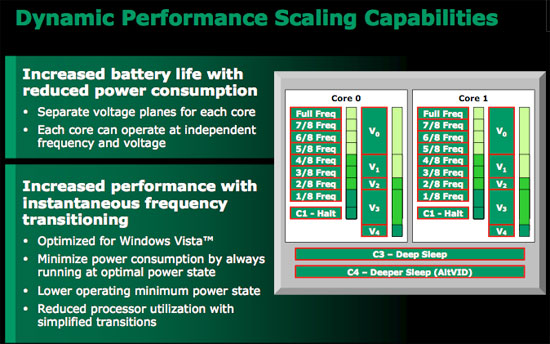AMD's Next-Generation Mobile Architecture Revealed: Griffin
by Anand Lal Shimpi on May 18, 2007 12:10 AM EST- Posted in
- CPUs
Truly Independent Power Planes
While architecturally Griffin is no different than today's Athlon X2s, it will draw noticeably less power in normal use. AMD is the first to announce the next step in multi-core power management: independent voltages and frequencies for each core. While Phenom splits the North Bridge and CPU cores into two separate voltage planes, Griffin goes one step further and puts each individual CPU core onto an independent voltage plane. The benefit is that not only can each core run at its own frequency, but it can also run at lower voltages giving you significant reductions in power consumption.
Dynamic power of a CPU can be determined by the following equation:
Power = ∝ * C * V^2 * F
Simply reducing the frequency of a processor (F) will result in a linear reduction in power consumption, but as you can see voltage (V) has an exponential relationship to power. Reducing both is ideal, and that's exactly what Griffin does.

Each core can run at one of 8 frequency steps and five voltage levels, independently of one another. Deep and deeper sleep states are supported, however AMD is currently looking into the possibility of implementing a C6 sleep state similar to what Intel announced for mobile Penryn. AMD wouldn't commit to whether or not we'd see a C6 state in Griffin, leading us to believe that it simply wasn't implemented at the time of Intel's Penryn announcements and there may not be enough time to add it in before launch.










36 Comments
View All Comments
mesyn191 - Friday, May 18, 2007 - link
For the mobile space a cheap power efficient platform (not just a CPU but a NB/SB, wireless chipset, graphics, driver support, etc...) is far more important than sheer CPU performance.Griffin sure won't beat C2D on performance IPC or clockspeed wise but it will provide them with a viable low cost set of one size fits all tech. that they can sell to the OEM's and that is where the major volume (and thus money) is.
Haltech - Friday, May 18, 2007 - link
Unleess AMD thinks they can add Barcelona to the mobile market Intel will continue to add market share in mobile front. Plus it seems like their implying ATI graphics only when talking about discrete graphics.One question- why 6 sata ports and 14 usb ports...
tygrus - Sunday, May 20, 2007 - link
Using desktop chipset becomes a problem of overkill, wasting silicon and power. Need to be slimmed down but that would still be more expensive due to smaller production.
How much power do they use when inactive ?
strikeback03 - Tuesday, May 22, 2007 - link
Are there any desktop chipsets that support 14 USB ports? I don't remember seeing any.JarredWalton - Friday, May 18, 2007 - link
There are plenty of notebook users that want decent performance with LOOOONG battery life. If AMD can provide better typical battery use, they could still make some waves. At present, Turion X2 is already competitive with C2D in low power states, but at load they fall behind. A few optimizations could help them in both areas.Lonyo - Friday, May 18, 2007 - link
But that won't really help them in a years time.Competing in 12 months with what Intel has today means than when Intel has moved on 12 months, they will likely be ahead again, so overall nothing will have changed, although the consumer will reap the benefits :)